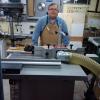What are the pros/cons of using a dado blade in a table saw vs a grooving cutter on a shaper? I can see how the shaper could be used for end-grain cuts on long stock, but are there other applications where one is superior?
(trying to justify why I need an adjustable shaper groover when I already have a dado set)





 Reply With Quote
Reply With Quote



